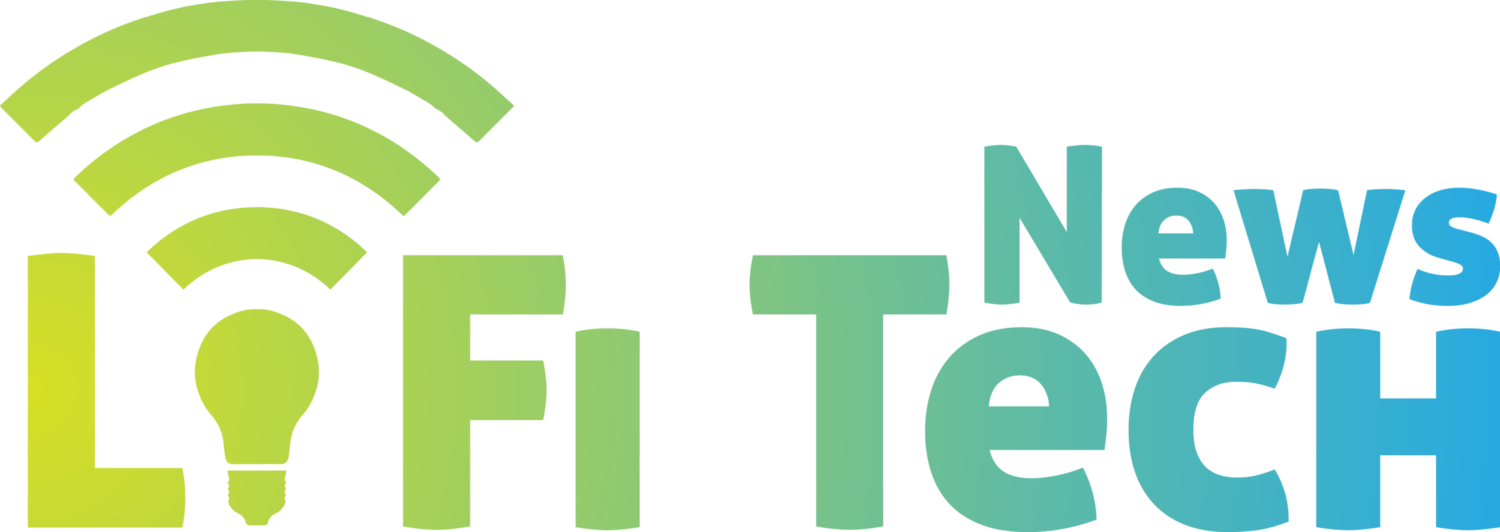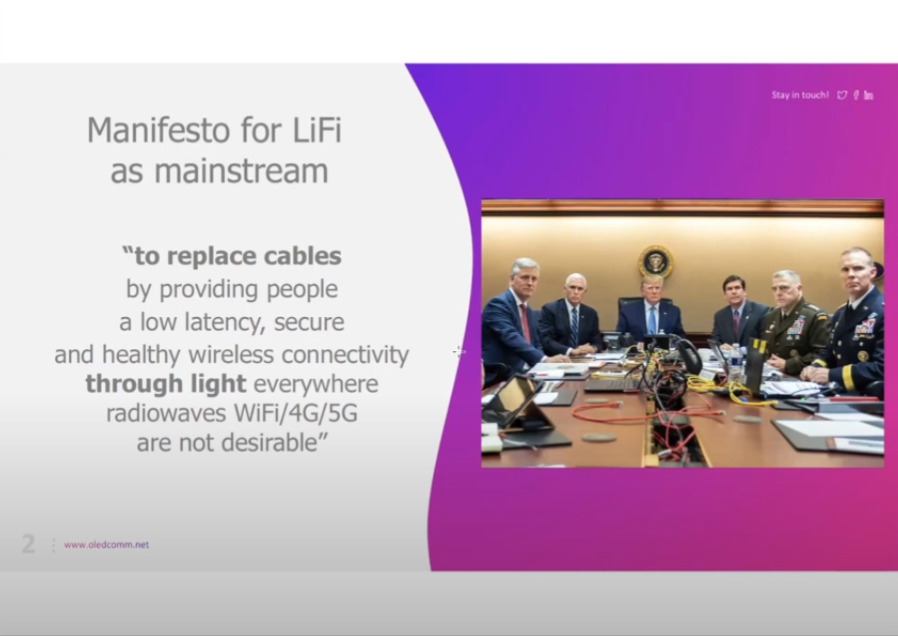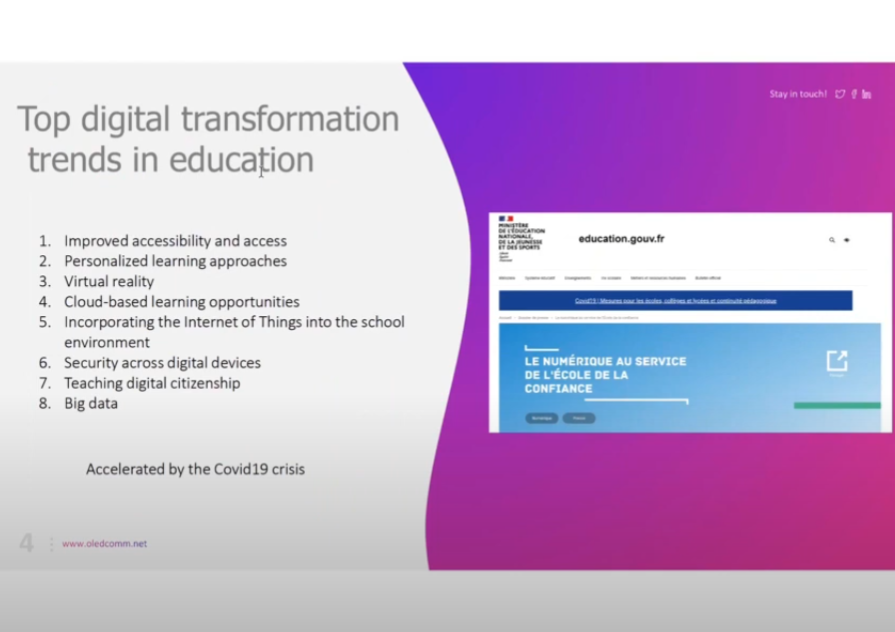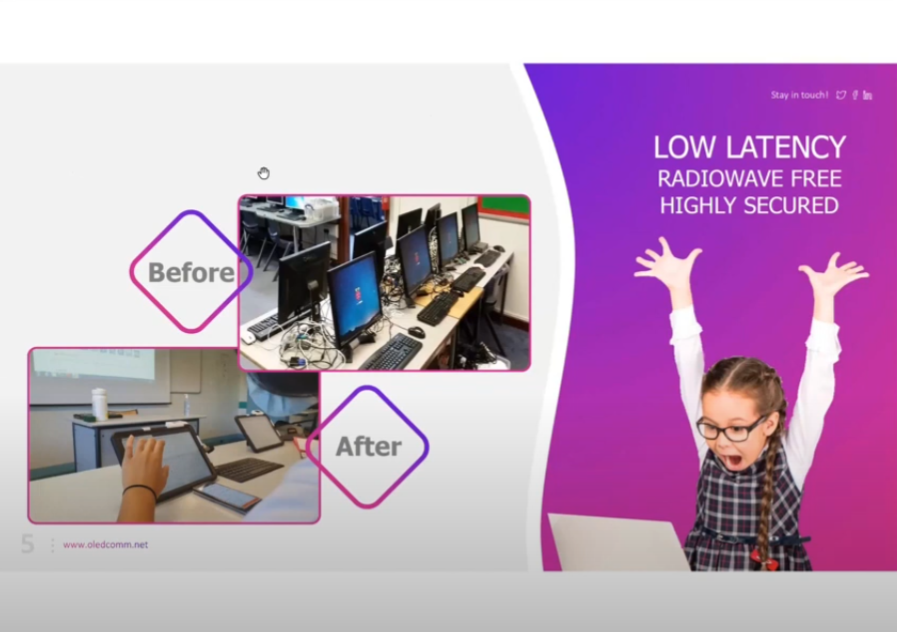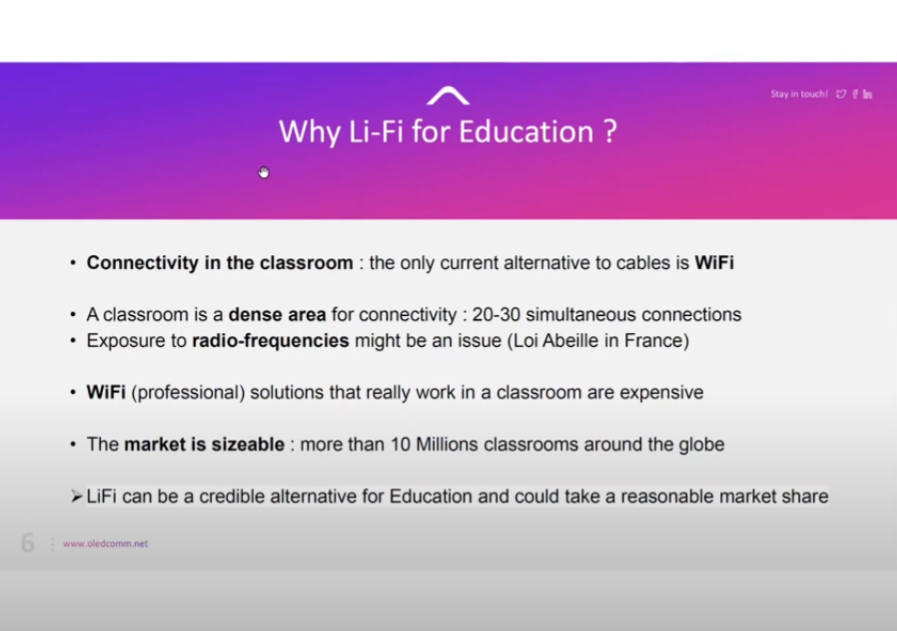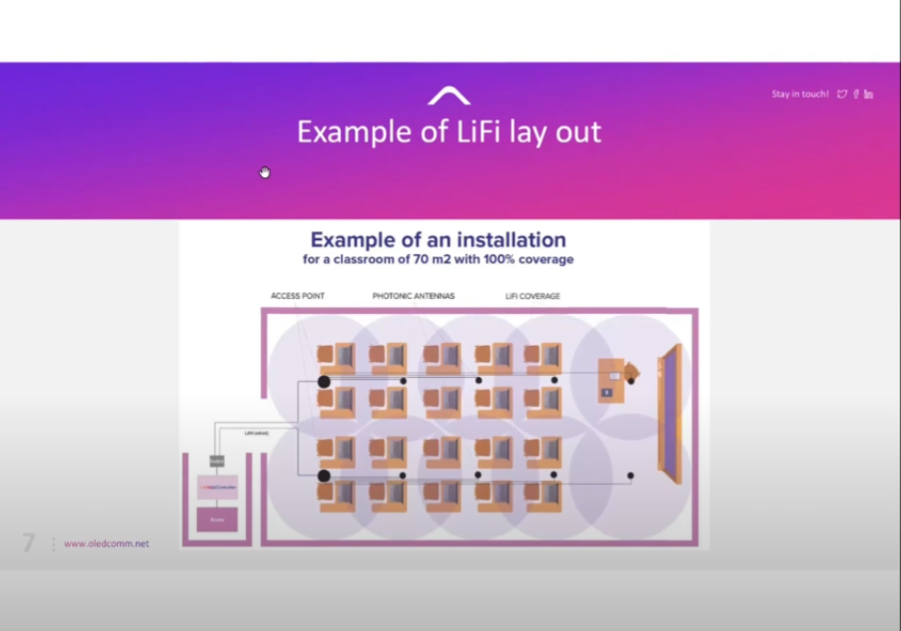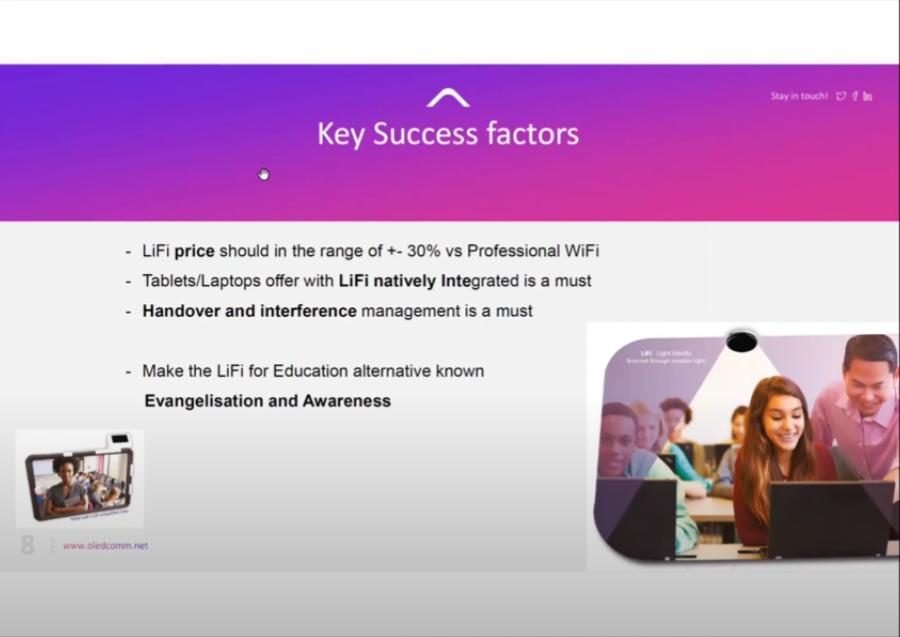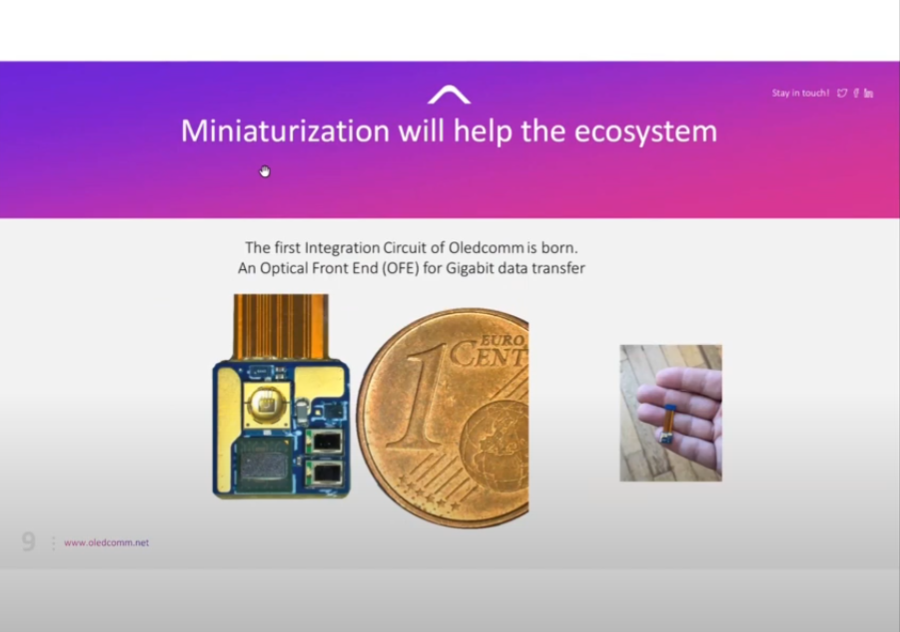Li-Fi Conference 2021 - Recap Part 6 - LiFi For Education
Li-Fi Conference 2021
In our last article from our ONLINE Li-Fi Conference 2021 recap series, we discussed the presentation delivered by Daniel Behnke from Weidmüller Deutschland on “LiFi Use Cases And Demonstration Scenarios For Smart Manufacturing”. The conference was organised by the Jakajima, the global High Tech Conference organiser, and the Light Communications Alliance.
Jakajima, Matchmaker for Innovators in the high tech industry, organises many events, ranging from LiFi Technology industry trends, 3D Printing to the Internet of Things, from Unmanned Cargo Aircraft to Health Tech, from 4D Printing to Photonics and from Vertical Farming to Sustainable Materials.
The online Li-Fi Conference included live presentations from researchers, executives and industry specialists from pureLiFi, Nokia, Signify, Orange, Radiocommunications Agency Netherlands, Velmenni, OLEDCOMM, HomeGrid Forum and Weidmüller Deutschland.
In another article recap series, we will talk about the presentation on LiFi For Education delivered by Benjamin Azoulay from OLEDCOMM. Before this, we will talk about OLEDCOMM.
OLEDCOMM
Oledcomm designs and develops LiFi network interface devices that enable high-speed wireless data communication. It also serves LiFi equipment in the telecom, datacom, personal electronics, and industrial markets. The company’s product portfolio includes hubs, routers, switches, adapters, drivers, power supplies, and many more.
Oledcomm was founded in 2012 and is currently based in Paris, France. Oledcomm's adventure began in 2005 in the research laboratories of the University of Versailles-Saint-Quentin with the first work on communication by visible light.
Following years of research & development and a passion for innovation, Oledcomm became the pioneer of LiFi (Light Fidelity) solutions and innovation on a global scale.
Based in the Paris region, Oledcomm employs around 25 people and designs complete solutions for LiFi operation, including microcontrollers, LiFi photoreceivers and software platforms.
Today, after more than 28 patents, 15 years of R&D, over 500 trusted clients and several awards, Oledcomm is pursuing a strong mission: to transform the 14 billion points of light in the world into a powerful communication network.
LiFi For Education Delivered By Benjamin Azoulay
Benjamin Azoulay, CEO at OLEDCOMM, was the sixth presenter at the online Li-Fi Conference 2021. He discussed in his presentation the LiFi Use Cases For Education.
Benjamin Azoulay is the founder, CEO and President of Oledcomm. He previously worked at Philips Lighting as CEO business home Europe & North America. He completed his Ingenieur degree in Automatics from Ecole centrale de Nantes.
Below are some points discussed about LiFi For Education:
THE LIFI FOR EDUCATION
Benjamin Azoulay started his presentation by saying the following:
“First of all, I'm going to try to focus on one use case, even if LIFI has many, many possible use cases, which is education because it's at the heart of our experience at OLEDCOMM in the last 18 months. And I would like just to share with you what is my view on the subject”.
Manifesto for LIFI AS MAINTREAM
”So, first of all, and before starting about this, I would like just to contribute to what my estimated colleagues have said about LIFI, the ecosystem and the LCA, what I realised during the last period is that at the end of the day, if I had there is one manifesto for the LIFI market as mainstream is we are here to replace cables at the end of the day. So, we are not here to compete with Wi-Fi, because I saw some questions about Wi-Fi being competitive in terms of price, we are here to offer an alternative to cables using light and everywhere the radio frequencies are not a solution, they are not desired sometimes they are not authorised sometimes in such an environment. So basically, to my opinion, LIFI is a niche market that a niche market for you know, in a huge market that is Wi-Fi, 4g, and 5g. And there are some spaces that are not covered with those technologies that we can cover as LIFI suppliers or as a LIFI ecosystem. So this is where I see and you know, these pictures show exactly. So I am not a Trump fan. But I think this picture is very nice because it shows the mess of tables inside a war room of the government. Because they are not authorised I guess to use Wi-Fi for security reasons in that environment. And if they would have used LIFI, it would get to the same latency, the same security as the cables with the convenience of having a wireless solution. So this is exactly where we could position our market as LIFI. So again, not to compete with radio frequencies, but to complement radio frequencies everywhere, the radio frequencies are not a solution. If we talk about the LIFI market, I think a lot of things have been said, I'm just mentioning here, a company called BIS research, a market research company, that shows that LIFI is an emerging market that that is obvious to everyone that the market would be of a size of $35 billion in 2028. It's very difficult to estimate. But let's say it's not a big market if you compare it to the radio frequency market, but you see that education is one of the main use cases that has been identified for the LIFI market and represent one of the big segments where the LIFI could have a real use case amongst close to healthcare and other aerospace we talked about, I will notice a few minutes ago.”
LIFI MARKET
“So, that's why at least at OLEDCOMM, you know, we have decided to focus on it because we think that we should specialise in one or two verticals in order to be able to succeed with the risk of a company like for us is the strategic dispersion. So we have decided to focus on education as one of the main that's vertical that we have decided to focus on. So, what are the trends in education? So, first of all, if I have to mention some big trends in education, of course, digital transformation is something that is happening in some countries and is even mandatory. In France for instance, there are there is a programme called L' Ecole numerique and every school will have to equip its students, children, classrooms, with connectivity with tablets and with laptops.”
TOP DIGITAL TRANSFORMATION TRENDS IN EDUCATION
“Because the digital transformation of the schools has completely transformed our accessibility to education, it's incredible how this digital transformation has affected the classrooms, has affected the teachers on how to teach their children and we know that with the COVID crisis, this has been accelerating even more because, during the lockdown, we were able to reach some of our students thanks to the digital transformation of the schools. The digital transformation enables also personalised learning approaches like virtual reality, cloud-based platforms are emerging everywhere today, you can even pass exams through digital tools that are today available in some countries and basically big data is also a big trend, the IoT is inside the schools are also being found like in any smart building. So, basically, the message here is that there is an enormous amount of efforts from all governments in our regions to digitalize the schools. And today, there is only one alternative today is Wi-Fi because as soon as you need to connect wirelessly classroom, you remember this is a very nice picture, remember the IT classroom of the past, you know with all cables everywhere, the nightmare of cables, and today with tablets that are connected directly wirelessly to the network.”, said Benjamin Azoulay.
alternative to Wi-Fi IN THE CLASSROOM
“So, this is a big challenge. And today, at OLEDcomm what we try to understand, is how we could offer an alternative to Wi-Fi, which is the only solution today. The only alternative today to have a wireless connection in the classroom. Knowing that we are in an environment where there are reasons for the LIFI to succeed in this environment. First of all, the conductive classroom is a complex dense area from a connectivity point of view, you have simultaneously 20 to 30 people connecting at the same time, and sometimes exactly at the same time because they are the following the same caution, the same lecture”.
WHY LIFI FOR EDUCATION?
“So, this is a big challenge. And today , at OLEDcomm what you try to understand, is how we could offer an alternative to Wi-Fi, which is the only solution today. The only alternative today to have a wireless connection in the classroom. Knowing that we are in an environment where there are reasons for the LIFI to succeed in this environment. First of all, the conductive classroom is a complex dense area from a connectivity point of view, you have simultaneously 20 to 30 people connecting at the same time, and sometimes exactly at the same time because they are the following the same caution, the same lecture.
The exposure to radiofrequency in this environment might be an issue because it's young children and sometimes in some countries like in France, there is a low recall Loi Abeille would just forbid exposing children below a certain age to radiofrequency. So there is concretely no alternative in that in those schools in those elementary schools, for instance, to connect in a wireless way. So LIFI in this environment is real, that's a must in order to connect those classrooms.
The fact that it is a dense area means that Wi-Fi connectivity is also a big challenge. I don't know-how, how is your experience personally of connectivity inside a school. But very often, after 1015 connection, it's extremely difficult to have because of the latency of the solutions installed. The high latency it is very difficult to have too many people connecting at the same time, which is a very high limiting factor to the experience of learning inside the classroom. There are solutions which is meaning having professional Wi-Fi boxes inside the classroom, not in the corridor, but inside some schools are today experiencing and trying to put in place but again, the more you densify the Wi-Fi boxes the higher the radio frequency exposure is high. And this seems to be another issue. That's why for those reasons LIFI is a real credible alternative for education in a market which is extremely sizeable. So we are not again you remember we said about the fact that LIFI can be an alternative a niche market in the huge radiofrequency environment but niche market it can be quite big. For instance, in education, there are more than 10 million classrooms that are step by step equipped with connectivity around the globe. I let you measure how big this market is.
EXAMPLE OF LIFI LAY OUT
“The example that I would like to share with you is how to, for instance, we can propose to instal a classroom this is a typical classroom of 10 metres by seven metres with the width around can be a little bit poor with around nine 10 antennas or access points with the coverage that you see here being shown. We can cover reasonably a classroom. So basically it means that having the infrastructure on the ceiling we have now today not tomorrow today. And I'm not talking about OLEDCOMM, I'm talking about the product of our colleagues Signify, pureLiFi and Lucibel. Well, there are solutions to connect a classroom in an easy way. And in a reasonable from an economical point of view also. So, this is a concrete example that we had at OLEDCOMM that really works today.”
KEY SUCCESS FACTORS
“The key success factor for LIFI in education to emerge, of course, is the price you are in an environment where I think this is my estimate that we should that LIFI total price should be in the range of plus or minus 30% versus professional Wi-Fi, to enable the How to say, early adopters, and then inflection point and move to the Wi-Fi, because then the benefits of the LIFI in terms of latency, in terms of comfort of connection, robustness, and we didn't talk about even security versus radiofrequency will have a big impact. So, professional LIFI is not an expensive though professional Wi-Fi 6 box is quite a price. And when a school is adopting your real connectivity series connectivity solution, then the price of LIFI could be reasonable, if it is plus or minus 30%. Versus the solutions today. The other key success factor is, of course, a laptop and tablets that need to be natively integrated, it's very difficult in this environment to have a dongle it's a very complicated our experience is that the professor will take will say hey guys, I will people will lose a dongle etc. So we need step by step to offer a solution to integrate the LIFI natively into tablets, into laptops or at least into cases to make it let's say to make the experience quite easy. And of course, some technical challenges because the classroom from a handover interference point of view is a very complex component. Not easy to do. So, from a technical point of view, we need to embed in order to have a solution that works with 20 to 30 people connecting at the same time in the same space to master completely do handover and reference management. And this is where the discussion we had earlier about how to embed those functionalities into the ITU G.VLC. IEEE 802.11bb is so important in the coming years and the role of the LCA is so important in the coming years to promote the solution and those functionalities. And again, at the end of the day, nothing is possible if we don't, if we are not able to make evangelization and awareness. Today, the people in all countries don't know they have an alternative to Wi-Fi. When they are moving to to to digitalize the schools, the only solution today is Wi-Fi. And we need to make sure they're at least aware that alternative to radiofrequency existing data in those environments, and that there is an alternative that could be let's say from a price point of view reasonable, and that is accessible to everyone. So, so creating awareness is absolute machinery to make the LIFI for educational success”.
miniaturization will help the ecosystem
“I want to finish my presentation by announcing that we'll be making a few days at the Mobile World Congress in Barcelona because all that is going to contribute to the ecosystem of the LIFI, we're not the only one our colleagues have, at least to my understanding our colleagues of pureLiFi has also announced last year, the first chipset that is completely integrated to enable LIFI integration to mobile devices. It's our turn now to announce the first integrated circuit of OLEDCOMM, this is a picture this is a real picture of an optical front end that is made of maybe recognise it has a vaxon of two photodiodes and the grey chipset that you see on the picture is the new gigabit chipset of OLEDCOMM. And you see the size but with this size, with this compactness, there is a new word that is coming for integration of the LIFI into laptops into tablets for education also into mobile devices into IoT and into all kinds of possible use cases are coming in the coming years. Thank you very much”.
You can also watch the full video presentation on the following YouTube link from Jakajima YouTube channel.
Li-Fi Conference 2022
The next Li-Fi Conference is coming up on the 28th of June 2022 between 10 am and 4.30 pm CET.
It is interesting to realise that lights that illuminate offices, homes, cars, factories, our streets and more locations also can connect us to data and hence power the growing demand for connectivity and speed.
At this conference professionals from all over the globe will gather together in order to share applications, ideas, new developments and ways to integrate Li-Fi in services, both for consumers and professionals.
This conference will be held Live and Online. The venue will be the High Tech Campus 1, The Strip 5656 AE Eindhoven The Netherlands.
Online tickets can be bought at the following link:
https://tikcit.com/register/61e002336d7fc4b6745cab83/
What is LiFi?
LiFi, also known as "Light Fidelity" is a wireless optical networking technology, which uses light-emitting diodes (LEDs) to transmit data. In 2011, professor Harald Haas made a LiFi demonstration at the TED (Technology, Entertainment, Design) Global Talk on Visible Light Communication (VLC).
VLC uses light as a medium to deliver high-speed communication like Wi-Fi and complies with the IEEE standard IEEE 802.15.7. The IEEE 802.15.7 is a high-speed, bidirectional, and fully networked wireless communication technology-based standard similar to Wi-Fi's IEEE 802.11.
How does LiFi work?
LiFi is a high speed, bidirectional, and fully networked wireless communication of data using light. LiFi constitutes of several light bulbs that form a wireless network.
When an electrical current goes through to a LED light bulb, a stream of light (photons) emits from the lamp. LED bulbs are semiconductor devices, which means that the brightness of the light flowing through them can change at extremely high speeds. The signal is sent by modulating the light at different rates. The signal can then be received by a detector that interprets the changes in light intensity (the signal) as data. Also when the LED is ON, you transmit a digital 1, and when it is OFF, you transmit a 0.
LiFi Benefits
The primary benefits of LiFi are as follows:
• Security: Provides entirely secure access. Where there is no light there is no data.
• Safety: Does not produce electromagnetic radiation and does not interfere with existing electronic systems.
• Localisation: Allows localisation due to the small coverage area of LiFi access point - localisation can be used for very precise asset tracking.
• Data density: Provides ubiquitous high-speed wireless access that offers substantially greater data density (data rate per unit area) than RF through high bandwidth reuse.
Credit to Oledcomm
LiFi Applications
LiFi can be used for so many applications and the list is increasing every year. You can read our updated list of Li-Fi applications at the following link:
Credit to pureLiFi
In conclusion, if you are also interested to hear more information about the OWNII Coin or enquire about LiFi devices such as the LiFiMax and Trulifi, you can contact us through our chatbot or by sending an email through our contact us form. If you enjoyed this post and would like to hear more updates about LiFi technology, subscribe to our newsletter. Don’t forget to subscribe to our social media accounts. You can also join our Telegram group about LiFi technology on this link:
https://t.me/joinchat/FMzOmsEKyJFrU6Af
